Slade and Sons had premises in Abbey Place for many years. Established in 1837, the firm was one of Torquay’s leading grocers. An advert in the Torquay and Tor Directory of 1846 announced to ‘The Nobility, Gentry and Public’ that Stiven’s & Co had appointed ‘Mr JJ Slade as sole agent for their GREEN GINGER WINE… a most delicious, safe and cooling beverage in spring water, superior to any mixture yet introduced’.
Photographs and text about Peter Cook.
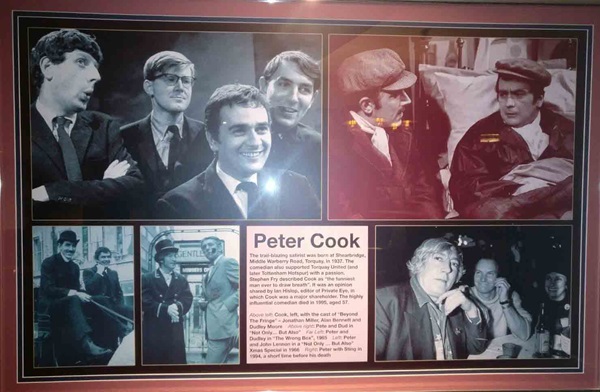
The text reads: The trail-blazing satirist was born at Shearbridge, Middle Warberry Road, Torquay, in 1937. The comedian also supported Torquay United (and later Tottenham Hotspur) with a passion. Stephen Fry described Cook as “the funniest man ever to draw breath”. It was an opinion shared by Ian Hislop, editor of Private Eye, in which Cook was a major shareholder. The highly influential comedian died in 1995, aged 57.
Above left: Cook, left, with the cast of Beyond The Fringe – Jonathan Miller, Alan Bennett and Dudley Moore
Above right: Pete and Dud in Not Only… But Also
Far left: Peter and John Lennon in a Not Only… But Also Xmas Special in 1966 Right: Peter with Sting in 1994, a short time before his death.
Photographs of Peter Cook.
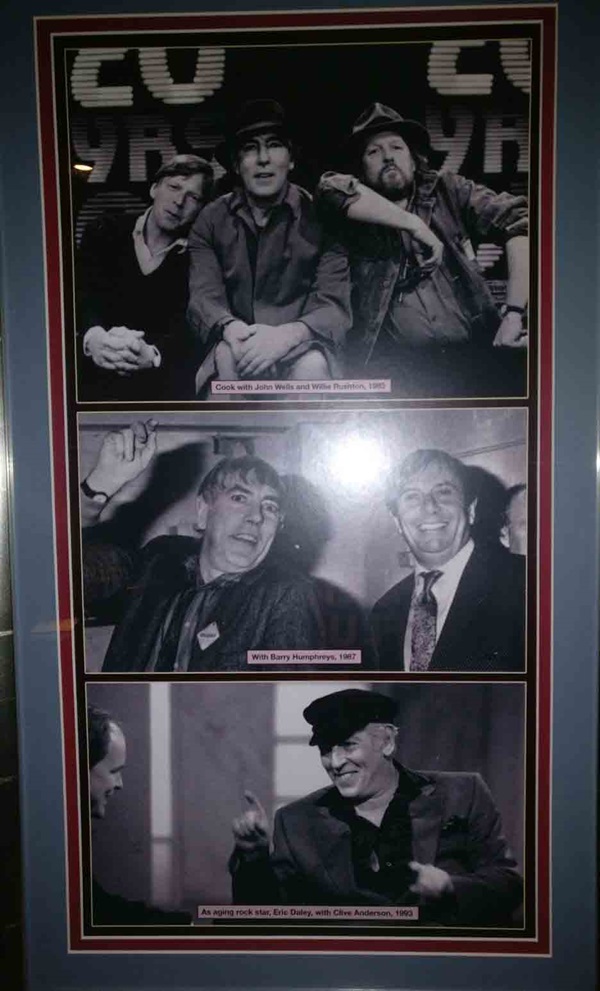
Top: Cook with John Wells and Willie Rushton, 1985
Middle: With Barry Humphreys, 1987
Bottom: As aging rock star, Eric Daley, with Clive Anderson, 1993.
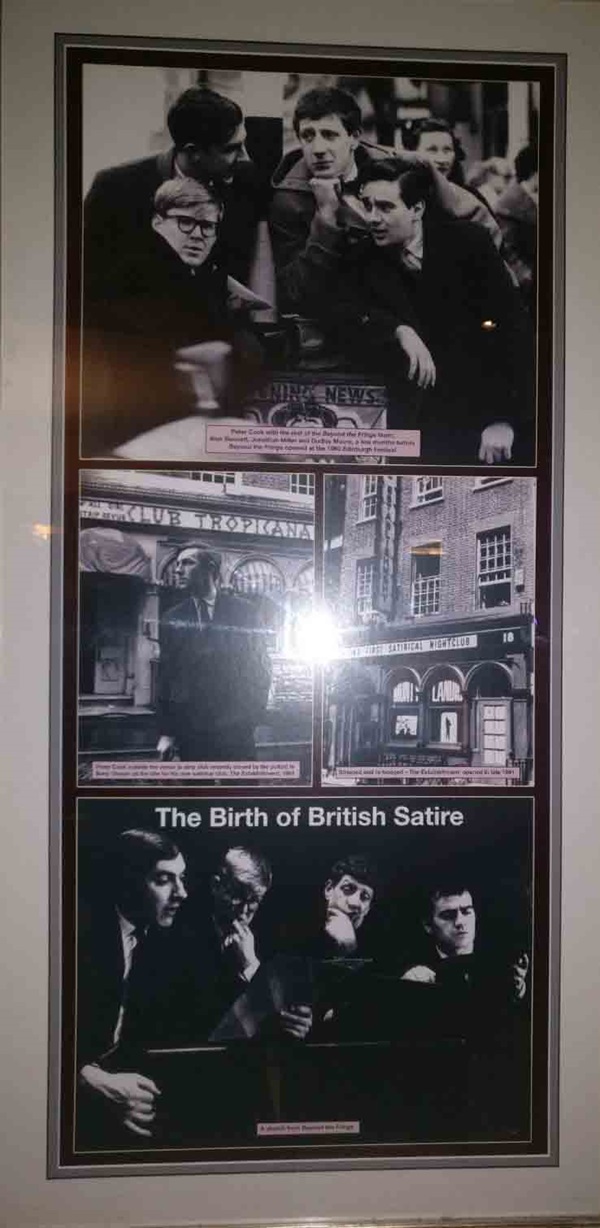
Top: Peter Cook with the rest of the Beyond the Fringe team: Alan Bennett, Jonathan Miller and Dudley Moore, a few months before Beyond the Fringe opened at the 1960 Edinburgh Festival.
Photographs, illustrations and text about Isambard Kingdom Brunel.
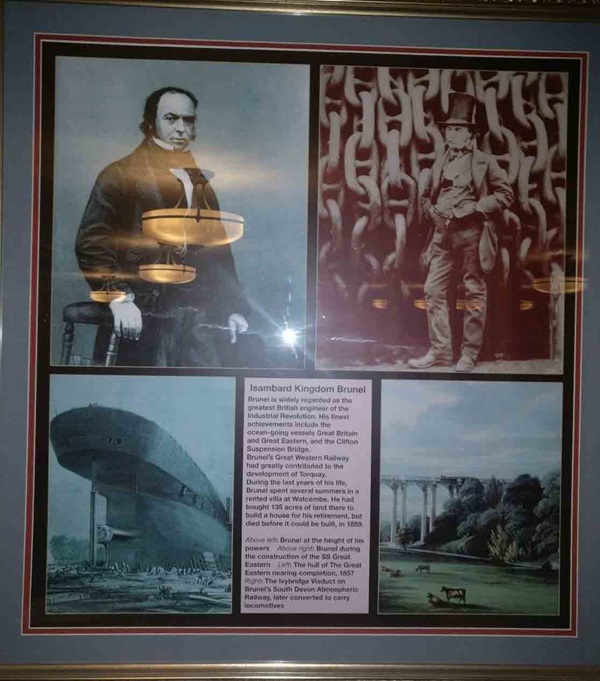
The text reads: Brunel is widely regarded as the greatest British engineer of the Industrial Revolution. His finest achievements include the ocean-going vessels Great Britain and Great Eastern, and the Clifton Suspension Bridge.
Brunel’s Great Western Railway had greatly contributed to the development of Torquay.
During the last years of his life, Brunel spent several summers in a rented villa at Watcombe. He had bought 135 acres of land there to build a house for his retirement, but died before it could be built, in 1859.
Above left: Brunel at the height of his powers
Above right: Brunel during the construction of the SS Great Eastern
Left: The hull of The Great Eastern nearing completion, 1857
Right: The Ivybridge Viaduct on Brunel’s South Devon Atmospheric Railway, later converted to carry locomotives.
Photographs and text about Oliver Heaviside.
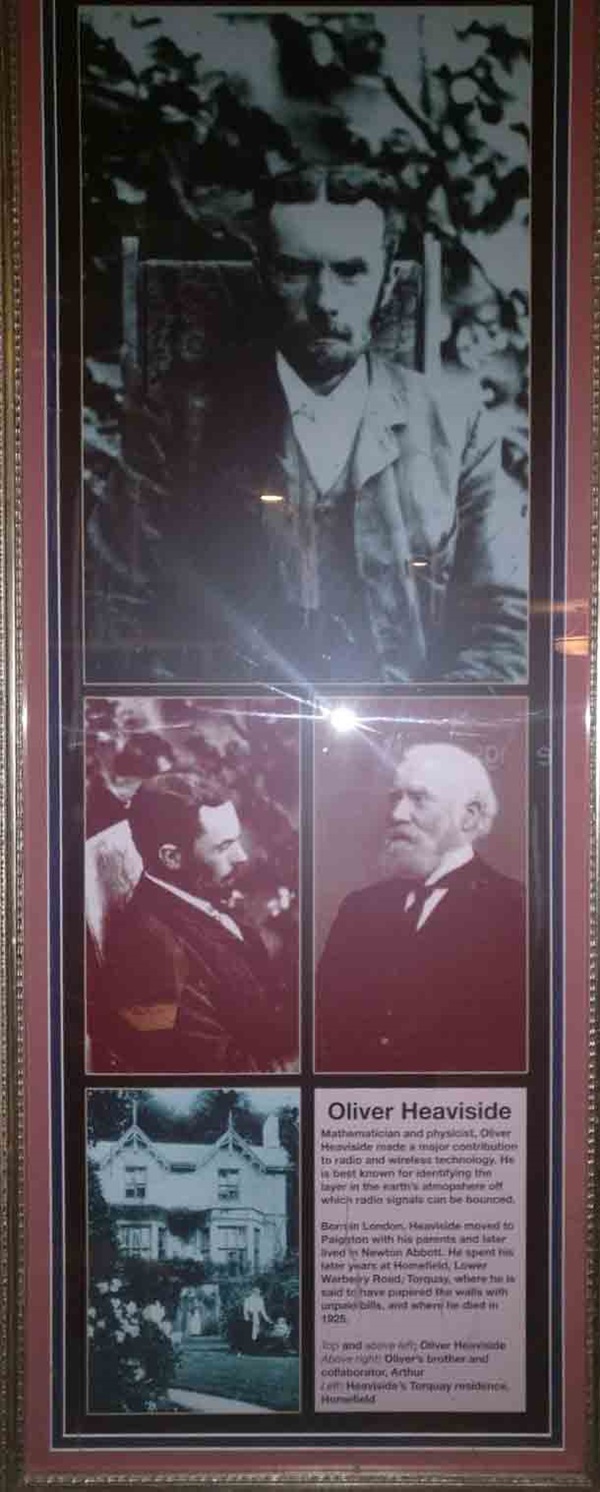
The text reads: Mathematician and physicist, Oliver Heaviside made a major contribution to radio and wireless technology. He is best known for identifying the layer in the earth’s atmosphere of which radio signals can be bounced.
Born in London, Heaviside moved to Paignton with his parents and later lived in Newton Abbott. He spent his later years at Homefield, Lower Warberly Road, Torquay, where he is said to have papered the walls with unpaid bills, and where he died in 1925.
Top and above left: Oliver Heaviside
Above right: Oliver’s brother and collaborator, Arthur
Left: Heaviside’s Torquay residence, Homefield.
Illustrations and text about Sir Walter Raleigh.

The text reads: The Elizabethan adventurer, courtier and poet was born in Devon, in 1552. He later sailed to America with his half-brother Sir Humphrey Gilbert, one-time occupier of Compton Castle (near Torquay). Legend has it that Sir Walter smoked the first pipe of tobacco in England whilst visiting Sir Humphrey.
Top: Walter Raleigh as a young man
Above: Raleigh and his son Wat in 1602
Below: Raleigh after the Battle of Cadiz.
Illustrations, a photograph and text about Oscar Wilde.
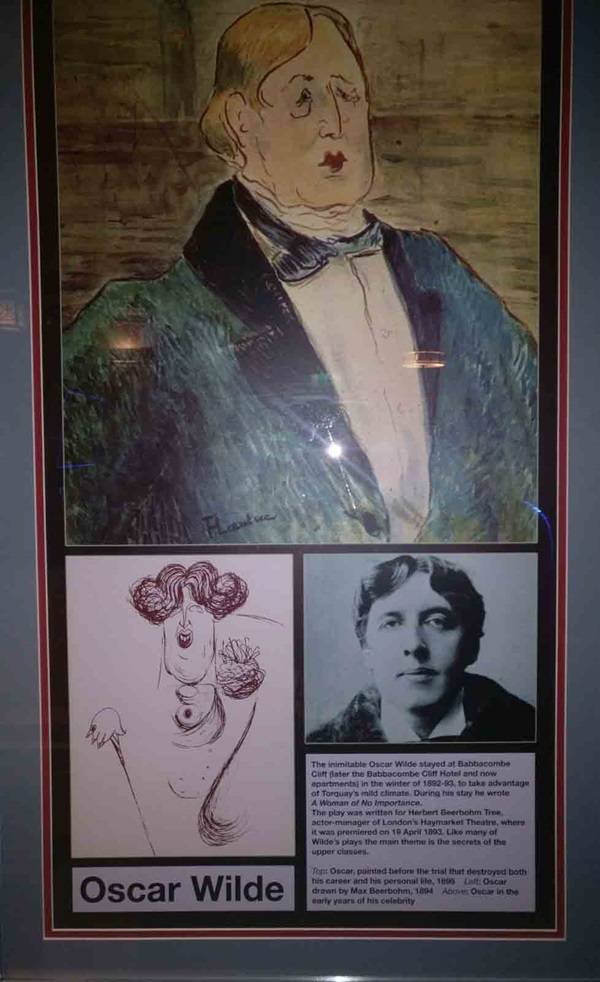
The text reads: The inimitable Oscar Wilde stayed at Babbacombe Cliff (later the Babbacombe Cliff Hotel and now apartments) in the winter of 1892-93, to take advantage of Torquay’s mild climate. During his stay he wrote A Woman of No Importance.
The play was written for Herbert Beerbohm Tree, actor-manager of London’s Haymarket Theatre, where it was premiered on 19 April 1893. Like many of Wilde’s plays the main theme is the secrets of the upper classes.
Top: Oscar, painted before the trial that destroyed both his career and his personal life, 1895
Left: Oscar drawn by Max Beerbohm, 1894
Above: Oscar in the early years of his celebrity.
Illustrations and text about Sir Humphrey Gilbert.

The text reads: Born in Galmpton, Devon, in c1539, Sir Humphrey Gilbert was an explorer, MP and half-brother (through his mother) of Sir Walter Raleigh. He was also cousin to another famous Devon seaman, Sir Francis Drake. Gilbert is one of the pioneers of English colonisation. He was granted a patent by Elizabeth I to find colonies in America and other lands. On his second voyage he reached Newfoundland, which he claimed for the Crown. The small vessel carrying Gilbert back to England was lost in a storm, in 1593.
Top: Sir Humphrey Gilbert
Centre: Sir Humphrey Gilbert taking possession of Newfoundland
Above: Compton Castle, the family home, c1800
Below: Compton Castle, c1910.
Photographs and text about William Froude.
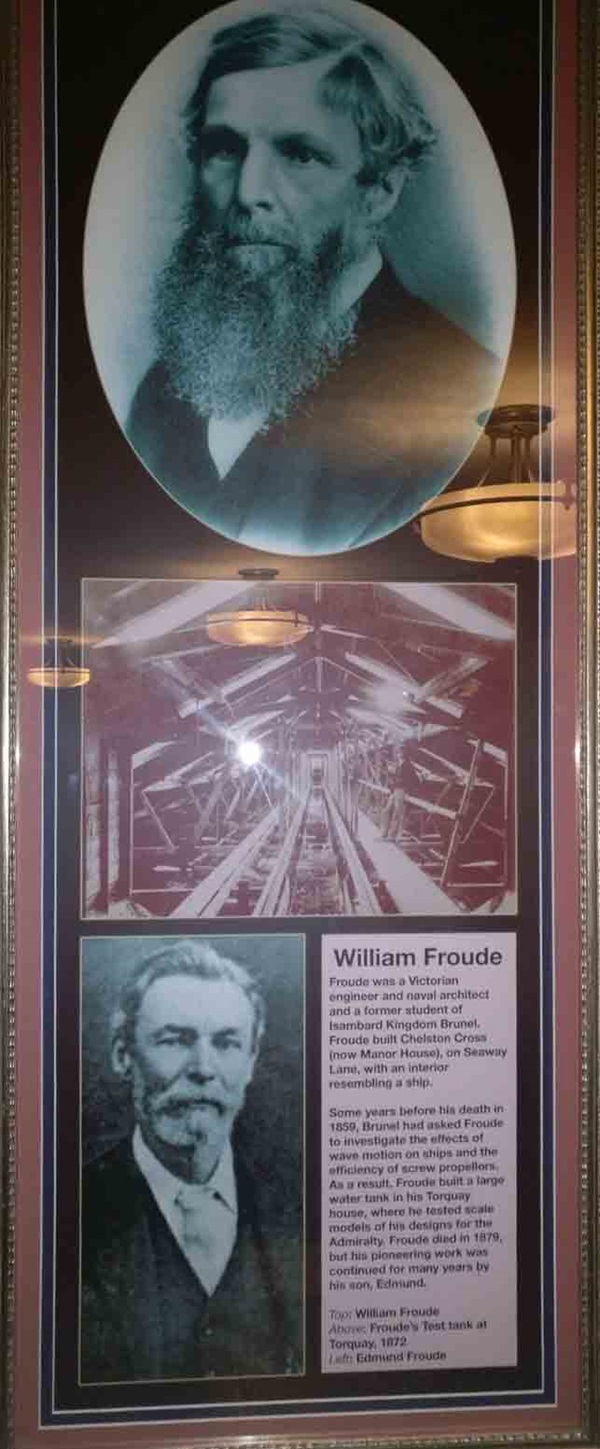
The text reads: Froude was a Victorian engineer and naval architect and a former student of Isambard Kingdom Brunel. Froude built Chelston Cross (now Manor House), on Seaway Lane, with an interior resembling a ship.
Some years before his death in 1859, Brunel had asked Froude to investigate the effects of wave motion on ships and the efficiency of screw propellers. As a result, Froude built a large water tank in his Torquay house, where he tested scale models of his designs for the Admiralty. Froude died in 1879 but his pioneering work was continued for many years by his son, Edmund.
Top: William Froude
Above: Froude’s test tank at Torquay, 1872
Left: Edmund Froude
Photographs, prints and text about Sir Richard Francis Burton and Colonel Percy Harrison Fawcett.
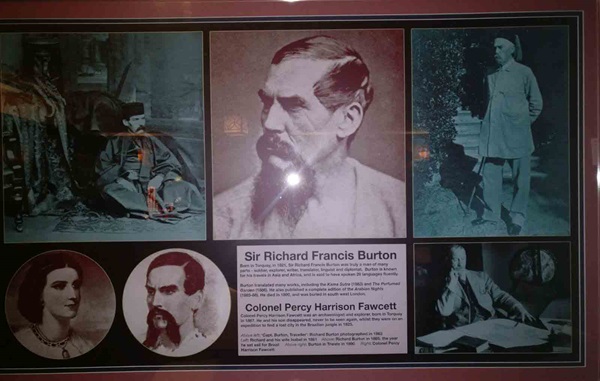
The text reads: Sir Richard Francis Burton
Born in Torquay, in 1821, Sir Richard Francis Burton was truly a man of many parts – soldier, explorer, writer, translator, linguist and diplomat. Burton is known for his travels in Asia and Africa, and is said to have spoken 29 languages fluently.
Burton translated many works, including the Kama Sutra (1883) and The Perfumed Garden (1886). He also published a complete edition of the Arabian Nights (1885-88). He died in 1890, and was buried in south west London.
Colonel Percy Harrison Fawcett
Colonel Percy Harrison Fawcett was an archaeologist and explorer, born in Torquay in 1867. He and his son disappeared, never to be seen again, whilst they were on an expedition to find a lost city in the Brazilian jungle in 1925.
Above left: Richard Burton photographed in 1863
Left: Richard and his wife Isabel in 1861
Above: Richard Burton in 1865, the year he set sail for Brazil
Above right: Burton in Trieste in 1890
Right: Colonel Percy Harrison Fawcett.
Photographs and text about Agatha Christie.
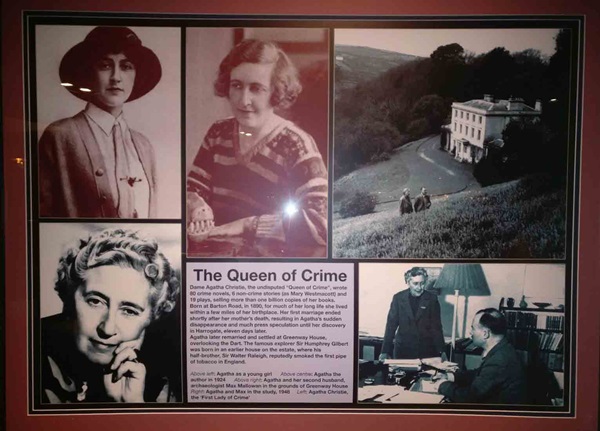
The text reads: Dame Agatha Christie, the undisputed ‘Queen of Crime’, wrote 80 crime novels, 6 non-crime stories (as Mary Westmacott) and 19 plays, selling more than one billion copies of her books. Born at Barton Road, in 1890, for much of her long life she lived within a few miles of her birthplace. Her first marriage ended shortly after her mother’s death, resulting in Agatha’s sudden disappearance and much press speculation until her discovery in Harrogate, eleven days later.
Agatha later remarried and settled at Greenway House, overlooking the Dart. The famous explorer Sir Humphrey Gilbert was born in an earlier house on the estate, where his half-brother, Sir Walter Raleigh, reputedly smoked the first pipe of tobacco in England.
Above Left: Agatha as a young girl
Above centre: Agatha the author in 1924
Above right: Agatha and her second husband, archaeologist Max Mallowan in the grounds of Greenway House
Right: Agatha and Max in the study, 1946
Left: Agatha Christie, the ‘First Lady of Crime’.
External photograph of the building – main entrance.
.jpg?h=400&&w=600&la=en&hash=338084AFA39AC4C9B4070CF297CBB85FD34B2DEE)
If you have information on the history of this pub, then we’d like you to share it with us. Please e-mail all information to: pubhistories@jdwetherspoon.co.uk